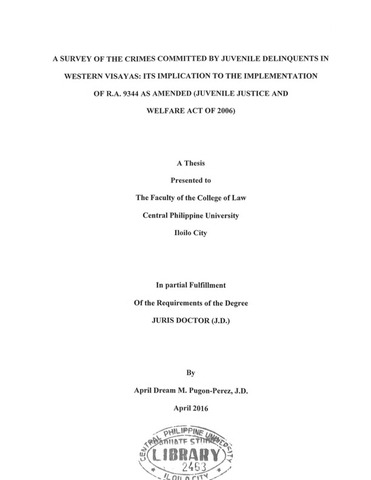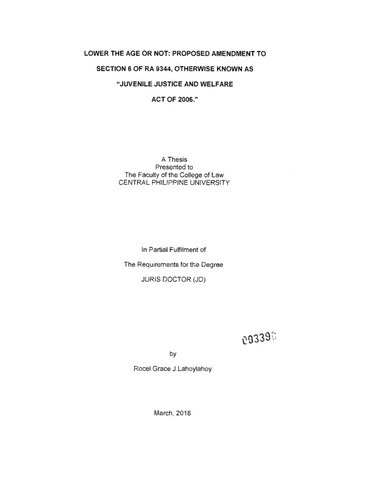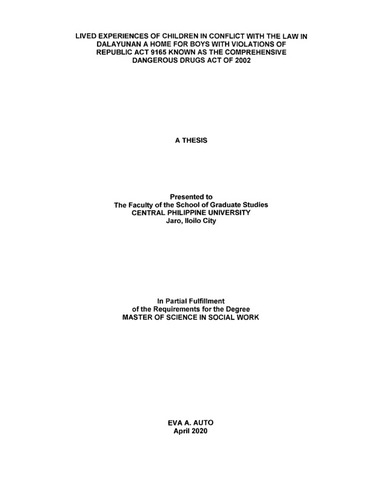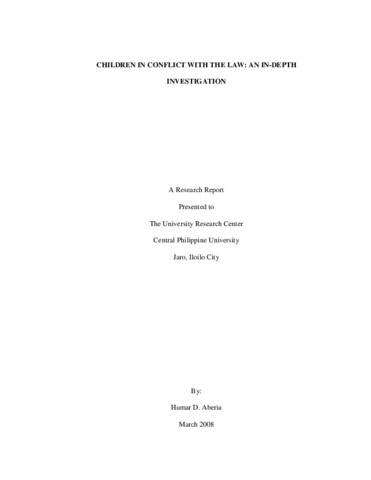A survey of the crimes committed by juvenile delinquents in Western Visayas: Its implication to the implementation of R.A. 9344 as amended (Juvenile Justice and Welfare Act of 2006)
Résumé
This study primarily aimed to determine the common crimes committed by Juvenile Delinquents in Western Visayas and its implication to the implementation of R.A. 9344 (Juvenile Justice and Welfare Act of 2006) as amended from year 2006 to 2013. Specifically, it aimed to determine crimes committed by juvenile delinquents in Western Visayas by age, sex, residence and status of cases; ascertain whether there was a significant change in the number of crimes committed by juvenile delinquents in Western Visayas from year 2006 to 2013; and whether the was a significant association in the crimes committed by juvenile delinquents in Western Visayas to their age, sex and residence. The data used was requested from the Department of Social Welfare and Development (DSWD) which are consolidated statistics from Philippine National Police (PNP) and DSWD Regional Rehabilitation Centers for Youth (RRCY) from year 2006 to 2013.
The common crimes committed by juvenile delinquents were theft, illegal use of rugby, physical injury, illegal possession of firearms, and illegal possession of deadly weapon. The crime incidence was increasing in 2006 to 2009 but was decreasing in 2010 to 2013. Those with age 10 to 15 years old had the highest number of crimes committed, followed by those aged 16 to 17, and aged 9 years old and below. Theft was the top crime committed by juvenile delinquents aged 10 to 15 years old and illegal use of rugby. Majority of the juvenile offenders were male wherein their most common crimes committed were theft and illegal use of rugby. A significant number of the juvenile offenders were male and residing at urban areas and usually committed theft, illegal use of rugby, physical injuries and illegal possession of deadly weapons. Almost all juvenile delinquents were released to parents while nearly 15 percent were referred to youth homes, diversion and intervention programs.
The result of the study recommends that the police officials should provide security measures in dealing with the juvenile delinquents and the government should include policy programs especially in dealing with male juveniles which have greater tendency to commit crimes in urban areas. The policy makers or lawmaking body should review the age limit for juvenile delinquents since age 10 to 15 years old been significantly associated with the crimes committed, followed by those aged 16 to 17, and aged 9 years old.
Description
Abstract only
Suggested Citation
Pugon-Perez, A. D. (2016). A survey of the crimes committed by juvenile delinquents in Western Visayas: Its implication to the
implementation of R.A. 9344 as amended (Juvenile Justice and Welfare Act of 2006) (Unpublished postgraduate thesis).
Central Philippine University, Jaro, Iloilo City.
Type
ThesisKeywords
Department
College of LawDegree
Juris DoctorShelf Location
GSL Theses 340.72 P415s
Physical Description
ii, 84 leaves
Collections
- Juris Doctor [144]
Related items
Showing items related by title, author, creator and subject.
-
Lower the age or not: Proposed amendment to Section 6 of RA 9344, otherwise known as “Juvenile Justice and Welfare Act of 2006.”
Lahoylahoy, Rocel Grace J. (2018)“The youth are the hope of our future” is a very common quote to the kind of society we lived in today where these young people can greatly contribute to the betterment of the community but can also become a problem if not ... -
Lived experiences of children in conflict with the law in Dalayunan: a Home for Boys with violations of Republic Act 9165 Known as the Comprehensive Dangerous Drugs Act of 2002
Auto, Eva A. (2020)This study is about the lived Experiences of CICLs in Dalayunan. The study was guided by the following objectives; to explore the lived experiences of the children in conflict with the law in Dalayunan, Iloilo City with ... -
Children in conflict with the law: An in-depth investigation
Aberia, Humar D. (2008-03)This descriptive-qualitative investigation attempted to study in-depth twelve cases of minors who committed various crimes in violation of the law. Results of the investigation showed that minors committed the crime of ...





